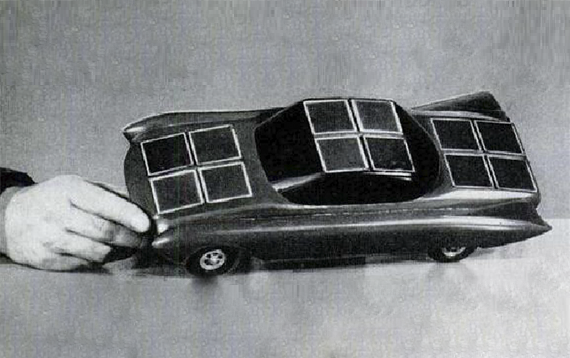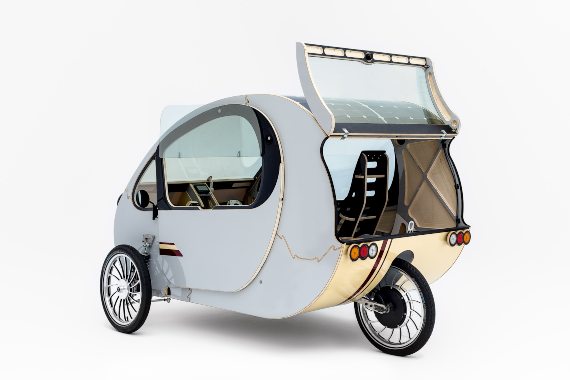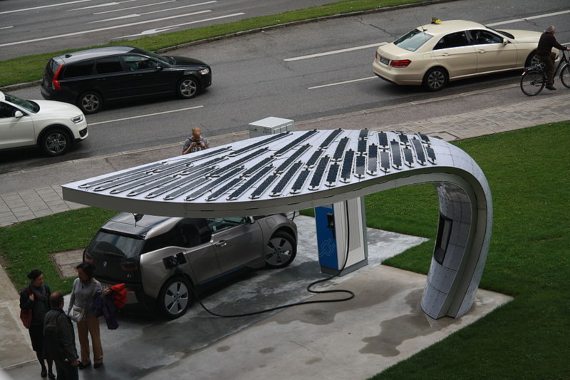On August 31, 1955, a small vehicle — just 15 inches (38 cm) long— became a major attraction at the General Motors Powerama auto show in Chicago. It was not a toy. It was the first solar-powered car in history, or more specifically, a futuristic miniature that attempted to establish the foundation for a future where vehicles are fueled by a clean, inexhaustible energy source: the sun.

The idea that cars could operate purely on solar power causes quite a stir, especially at a time when the fight against the climate crisis is high on the agenda of major international organizations and one of its primary lines of action is to rethink how people get around. So, more than 60 years later, why isn’t the automobile market full of solar-powered alternatives?
A decade-long evolution
This first miniature model “solar car” was named Sunmobile and was the brainchild of William G. Cobb, a General Motors employee. It ran on 12 photovoltaic cells attached to its roof, producing the energy needed to power the little vehicle’s engine. The Sunmobile painted a futuristic picture of where the car industry could be headed, except that it was impossible to bring the concept to fruition because the maximum power that the solar panels could produce was not enough to run any of the automobiles of the era. It was the first of many prototypes.
The first real-size, sun-powered model came a few years later, in 1960. U.S. company, International Rectifier, converted a 1912 Baker Electric, into a solar-powered car that reached just over 12 mph (20km/h) with a duration of three hours.
The Bluebird, built by Ed Passeneri in 1977 is considered by some to be the first real solar vehicle. It had three wheels and could move by dint of the energy created by photovoltaic cells, without the use of a battery. In 1982, The Quiet Achiever became the first solar-powered car that could go for long distances. It covered 2,485 miles (4,000 km), traveling from the west coast of Australia to the east coast in less than 20 days.
The 1980s ushered in what is still today the primary use of solar-powered vehicles: racing. In 1985, the first official solar-powered vehicle race was held in Switzerland: the Tour de Sol. The best known race today is the World Solar Challenge, which was first held in 1987. It is now a biannual event, and for the most part its participants are university and corporate teams. The automobiles that participate are light vehicles covered in solar panels — typically a single square — and they move on three wheels about the size of bicycle tires. Hence they are a far cry from a workable prototype for present day commercial automobiles.
Today’s solar-powered automobiles
Apart from the world of racing, photovoltaic cell technology is not currently prevalent in the automobile market. The primary obstacles are the prohibitive cost associated with rolling out the technology, the space constraints which cap the number of panels that can be placed on the car, the distance the car can travel, and the speed it can reach.
There are a number of solar-powered vehicle initiatives that have tried to open the door to the consumer. One of the most talked about is Lightyear One. With a distance capacity of 435 miles (700 kilometers), it uses photovoltaic cells that, according to its creators, can store 20 percent more energy than traditional ones, and they operate independently, even when some are covered by shade. With a €150,000 price tag, it is not a viable option for most people, but the idea that its technology could be used by other manufacturers holds interesting promise.

Another strong bet is the Sono Sion, which uses 248 solar cells spread across its body, providing it an additional 21 miles (34 km) of distance capacity to the 155 miles (250 km) it can run thanks to its battery charge. It is priced on the market at €25,500.
Other projects that aspired to be much more accessible have stalled due to financing difficulties. One of these cases is the Spanish-designed mö, a two-seater created for city travel with a price tag of €5,000. The team behind the project recently announced they are discontinuing the initiative due to a lack of funding to complete production of their first units.
Is there a future for solar-powered cars?
Although the reality of an accessible, mainstream solar-powered car continues to be a distant reality, solar energy can contribute in other ways to more sustainable transportation. Solar-charged vehicles themselves are not fitted with solar panels, but they are powered by electricity that is externally generated by solar panels, which can be located on the roof of a house or garage, etc.

There is also the possibility, already proven in various commercial models, of placing solar panels on the roofs of electric or hybrid cars, as a supplementary power source that does not intend to actually move the car, but can provide the energy needed for other uses, like powering the air conditioning.
At present, using photovoltaic panels for automobile travel has not proven to be an efficient solution to the problem of replacing fossil fuels, but it could serve to supplement other systems. After all, the future of sustainable transportation relies on knowing how best to exploit each clean technology.
Comments on this publication